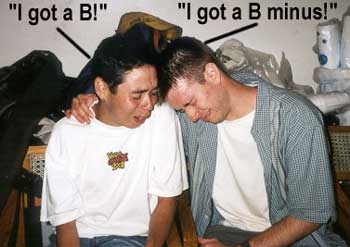|
When it comes to correcting papers and
grading tests, purple is emerging as the new red.

"If you see a whole paper of red, it looks pretty
frightening," said Sharon Carlson, a health and
physical education teacher at John F. Kennedy Middle
School in Northampton. "Purple stands out, but
it doesn't look as scary as red."
 That's
the cue pen makers and office supply superstores say
they have gotten from teachers as the $15 billion back-to-school
retail season kicks off. They say focus groups and conversations
with teachers have led them to conclude that a growing
number of the nation's educators are switching to purple,
a color they perceive as "friendlier" than
red. That's
the cue pen makers and office supply superstores say
they have gotten from teachers as the $15 billion back-to-school
retail season kicks off. They say focus groups and conversations
with teachers have led them to conclude that a growing
number of the nation's educators are switching to purple,
a color they perceive as "friendlier" than
red.
As a result, Paper Mate introduced purple
to its assortment of blue, red, and green X-Tend pens
and increased distribution of existing purple pens this
school year. Barry Calpino, Paper Mate's vice president
and general manager, estimated that the Bellwood, Ill.,
company boosted production of purple pens by at least
10 percent. He said purple will now be a standard color
in all its new product lines.
Office superstores such as Staples and
OfficeMax also are making a splash with purple pens,
stocking more of them, adding purple to multicolor packs,
and selling all-purple packs. By comparison, Staples
did not stock any exclusively purple pen packs last
year and it hardly had any purple pens in its stores
two years ago, said Robert George, the Framingham chain's
senior vice president of general merchandise. Now, he
said, sales of purple pens are growing at a faster clip
than pen sales overall.
A mix of red and blue, the color purple
embodies red's sense of authority but also blue's association
with serenity, making it a less negative and more constructive
color for correcting student papers, color psychologists
said. Purple calls attention to itself without being
too aggressive. And because the color is linked to creativity
and royalty, it is also more encouraging to students.
"The concept of purple as a replacement
for red is a pretty good idea," said Leatrice Eiseman,
director of the Pantone Color Institute in Carlstadt,
N.J., and author of five books on color. "You soften
the blow of red. Red is a bit over-the-top in its aggression."
For office supply stores, color and
fashion trends spell opportunity and risk. The trends
allow them to freshen up staid old categories such as
pens and markers, fueling sales. But getting a trend
wrong -- betting on purple pens when teachers and students
are buying green, for example -- can cost them sales
during a critical retail period.
Red's legacy as the color used in correcting
papers and marking mistakes goes back to the 1700s,
the era of the quill pen. In those days, red ink was
used by clerks and accountants to correct ledgers. From
there, it found its way into teachers' hands.
But two or three decades ago, an anti-red
sentiment began surfacing among teachers. Since then,
no one color had emerged as red's replacement.
Is purple here to
stay?
"I do not use red," said Robin
Slipakoff, who teaches second and third grades at Mirror
Lake Elementary School in Plantation, Fla. "Red
has a negative connotation, and we want to promote self-confidence.
I like purple. I use purple a lot."
Sheila Hanley, who teaches reading and
writing to first- and second-graders at John F. Kennedy
Elementary School in Randolph, said: "Red is definitely
a no-no. But I don't know if purple is in."
Hanley said a growing contingent of
her colleagues is using purple. They prefer it to green
and yellow because it provides more contrast to the
black or blue ink students are asked to write in. And
they prefer it to orange, which they think is too similar
to red.
But aside from avoiding red, Hanley
said she is not sure color matters much. At times, she
uses sticky notes rather than writing on a child's paper.
What's important, she said, is to focus on how an assignment
can be improved rather than on what is wrong with it,
she said.
Ruslan Nedoruban, who is entering seventh
grade at his Belmont school, said red markings on his
papers make him feel "uncomfortable."
His mother, Victoria Nedoruban, who
is taking classes to improve her English, said she thinks
papers should be corrected in red.
"I hate red," she said. "But
because I hate it, I want to work harder to make sure
there isn't any red on my papers."
Red has other defenders. California
high-school teacher Carol Jago, who has been working
with students for more than 30 years, said she has no
plans to stop using red. She said her students do not
seem psychologically scarred by how she wields her pen.
And if her students are mixing up "their,"
"there," and "they're," she wants
to shock them into fixing the mistake.
"We need to be honest and forthright
with students," Jago said. "Red is honest,
direct, and to the point. I'm sending the message, 'I
care about you enough to care how you present yourself
to the outside world.' " |